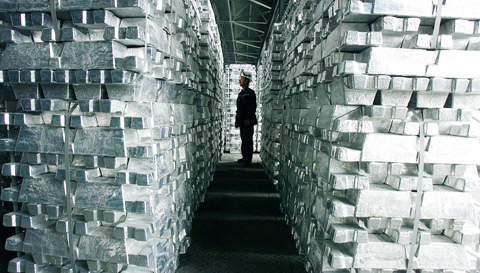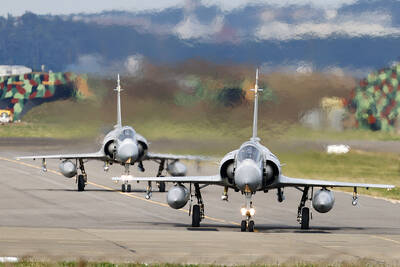Commodities prices fell in the past week, giving back some of their recent gains while precious metals slipped as more confident investors looked to exit safe-havens such as gold, analysts said.
OIL: Oil prices fell below US$70 on profit-taking on Friday after a brief rally spurred by hopes that the worst may be over for the ailing global economy.
Early gains were also supported by continuing attacks on oil facilities in Nigeria and concerns about political developments in Iran, OPEC’s second largest producer, following disputed presidential elections there.

PHOTO: REUTERS
New York’s main futures contract, light sweet crude for delivery in July, shed US$1.82 from Thursday’s close to end at US$69.55 a barrel after climbing past US$72.
In London trading, Brent North Sea crude for August delivery dropped US$1.87 to US$69.19 per barrel.
Traders said prices came under pressure ahead of tomorrow’s expiry of the New York futures July contract.
PRECIOUS METALS: Gold prices slipped further after a recent rally toward US$1,000 an ounce.
“With the recent recovery in risk appetite, safe-haven demand for gold has receded,” BNP Paribas analyst Anne-Laure Tremblay said.
By late Friday on the London Bullion Market, gold dropped to US$933.75 an ounce from US$937.25 a week earlier.
Silver fell to US$14.23 an ounce from US$15.07.
On the London Platinum and Palladium Market, platinum slipped to US$1,209 an ounce at the late fixing on Friday from US$1,241.
Palladium declined to US$241 an ounce from US$252.50.
BASE METALS: Base metals prices slid after recent sharp gains. China’s strong purchase of metals spurred other investors to buy up commodities in recent weeks.
By Friday on the London Metal Exchange, copper for delivery in three months fell to US$5,039 a tonne from US$5,255 a week earlier.
Three-month aluminum dropped to US$1,665 a tonne from US$1,670.
GRAINS AND SOYA: Grains and soya prices retreated on strong supply expectations.
By Friday on the Chicago Board of Trade, maize for delivery in July fell to US$3.94 a bushel from US$4.25 a week earlier.
July-dated soyabean meal — used in animal feed — decreased to US$12.01 from US$12.45.
Wheat for July dropped to US$5.10 a bushel from US$5.84.

Taiwan is gearing up to celebrate the New Year at events across the country, headlined by the annual countdown and Taipei 101 fireworks display at midnight. Many of the events are to be livesteamed online. See below for lineups and links: Taipei Taipei’s New Year’s Party 2026 is to begin at 7pm and run until 1am, with the theme “Sailing to the Future.” South Korean girl group KARA is headlining the concert at Taipei City Hall Plaza, with additional performances by Amber An (安心亞), Nick Chou (周湯豪), hip-hop trio Nine One One (玖壹壹), Bii (畢書盡), girl group Genblue (幻藍小熊) and more. The festivities are to

Auckland rang in 2026 with a downtown fireworks display launched from New Zealand’s tallest structure, Sky Tower, making it the first major city to greet the new year at a celebration dampened by rain, while crowds in Taipei braved the elements to watch Taipei 101’s display. South Pacific countries are the first to bid farewell to 2025. Clocks struck midnight in Auckland, with a population of 1.7 million, 18 hours before the famous ball was to drop in New York’s Times Square. The five-minute display involved 3,500 fireworks launched from the 240m Sky Tower. Smaller community events were canceled across New Zealand’s

‘IRRESPONSIBLE’: Beijing’s constant disruption of the ‘status quo’ in the Taiwan Strait has damaged peace, stability and security in the Indo-Pacific region, MOFA said The Presidential Office yesterday condemned China’s launch of another military drill around Taiwan, saying such actions are a “unilateral provocation” that destabilizes regional peace and stability. China should immediately stop the irresponsible and provocative actions, Presidential Office spokeswoman Karen Kuo (郭雅慧) said, after the Chinese People’s Liberation Army (PLA) yesterday announced the start of a new round of joint exercises around Taiwan by the army, navy and air force, which it said were approaching “from different directions.” Code-named “Justice Mission 2025,” the exercises would be conducted in the Taiwan Strait and in areas north, southwest, southeast and east of Taiwan

UNDER WAY: The contract for advanced sensor systems would be fulfilled in Florida, and is expected to be completed by June 2031, the Pentagon said Lockheed Martin has been given a contract involving foreign military sales to Taiwan to meet what Washington calls “an urgent operational need” of Taiwan’s air force, the Pentagon said on Wednesday. The contract has a ceiling value of US$328.5 million, with US$157.3 million in foreign military sales funds obligated at the time of award, the Pentagon said in a statement. “This contract provides for the procurement and delivery of 55 Infrared Search and Track Legion Enhanced Sensor Pods, processors, pod containers and processor containers required to meet the urgent operational need of the Taiwan air force,” it said. The contract’s work would be